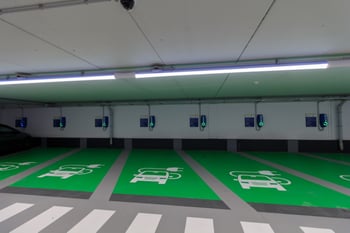 Electric cars are becoming more prevalent and car parks are facing a new risk with the growing numbers of cars being charged in them. This may lead to a number of fires in their lithium-ion batteries, that will pose a challenge to firefighters and to those responsible for safety in the car parks.
Electric cars are becoming more prevalent and car parks are facing a new risk with the growing numbers of cars being charged in them. This may lead to a number of fires in their lithium-ion batteries, that will pose a challenge to firefighters and to those responsible for safety in the car parks.
As of December 2021, it is estimated that 2% of all cars in the UK is electric or hybrid and there was a total of 190,000 new pure electric cars registered in the UK, representing a 76% increase on the 2020 figures. The Society of Motor Manufacturers and Traders (SMMT) is forecasting that a total of 1.72 million new cars will be registered in 2022 as a whole, with a quarter of all being plug-in vehicles and one in six being a pure electric vehicle.
The time needed to charge an electric car can be anything between 30 minutes and 12 hours, depending on the size of the battery and the speed of the charging point. Pure electric cars, with their larger batteries, will be at the longer end of that time frame. Car parks are likely to respond to this need by installing numerous charging points. The RISC Authority, the research body supported by the insurance industry, has issued guidance on the charging of cars in residential and workplace environments, which can be accessed here. Although strictly this does not apply to car parks, it is worth noting the guidance. It says: ‘the fire safety management strategy should consider practical passive, active and managerial control measures as part of the fire risk assessment for the premises when selecting and designing areas for charging electric vehicles and mobility scooters.
The Dept for Leveling Up.. (DLUHC have also recently published Approved Document S, which provides guidance on the provision of charging points in new and refurbished buildings. The Document focusses on the provision and quantity of charging points, not the electrical or fire safety of them.
Because charging of electric vehicles will often continue when premises are unoccupied, the measures to be considered should include:
- physical segregation of the charging points from process and storage areas (see section 5);
- provision of suitable power supply, control and isolation systems;
- suitable fire detection and warning installations in case of fire;
- provision of suitable portable firefighting equipment;
- development of an emergency action plan to protect life and property and ensure the continuing functioning of the business in the case of fire; and
- staff training in the safe charging of vehicles and the actions to take in the event of fire, including the safe shut down of the charging process and evacuation of the premises.’
In car parks, there is the additional risk that a fire in one vehicle can spread to another, e.g. from an electric vehicle to another vehicle, whether electric, hybrid or the still more common fossil fueled vehicles, or vice versa for that matter.
The perception, however, is that charging electric vehicles increases the risk of fire starting.
All fires are risky, but these are particularly dangerous because of the nature of the lithium-ion batteries that are used in electric cars. If they burn, it is very difficult to put out the fire. When researchers at the NFPA (the United States’ National Fire Protection Association) carried out tests on lithium-ion batteries, they came to the following conclusions:
“In each of the six full-scale burn tests, firefighters at the test site found that they needed to flow large amounts of water on the batteries, because fire kept flaring up even after it appeared to be extinguished. In one test, a battery fire reignited 22 hours after it was thought to be extinguished.
“‘Everything looked normal,’” recalled Andrew Blum, a researcher at the firm Exponent, which conducted the tests. ‘When we looked at the battery through a thermal imager, everything was back to ambient temperatures; the fire was extinguished as we would define it. But there was something going on internally in the module, and we just couldn’t tell.’ In two of the tests, firefighters ran out of air and had to switch tanks because of the length of time it took to fully extinguish the battery.”
And toxic gases are a particular problem. Researchers in Sweden have found that large volumes of toxic fluoride gases and smoke will be emitted in case of a lithium-ion battery fire:
All this makes it even more important to take smoke ventilation in car parks seriously. Adequate smoke ventilation can both remove toxic fumes and make the job of firefighters easier. The advent of larger numbers of electric cars is to be welcomed, but we must be ready for the consequences.
The way we use cars may well change. As we advance towards more autonomous vehicles, patterns of ownership may well change, with cars becoming more like taxis. But those vehicles, however they are owned, will still need to be parked and charged – and we must be aware and prepared for the risks involved.
If you are working on a new or refurbishment project that requires car park smoke ventilation, talk to Colt for a free consultation.
 Conor Logan is Associate Technical Director of Colt UK, Smoke and Climate Control Division. Conor designs innovative smoke control and HVAC systems and was Chairman of the Smoke Control Association for over 9 years.
Conor Logan is Associate Technical Director of Colt UK, Smoke and Climate Control Division. Conor designs innovative smoke control and HVAC systems and was Chairman of the Smoke Control Association for over 9 years.


